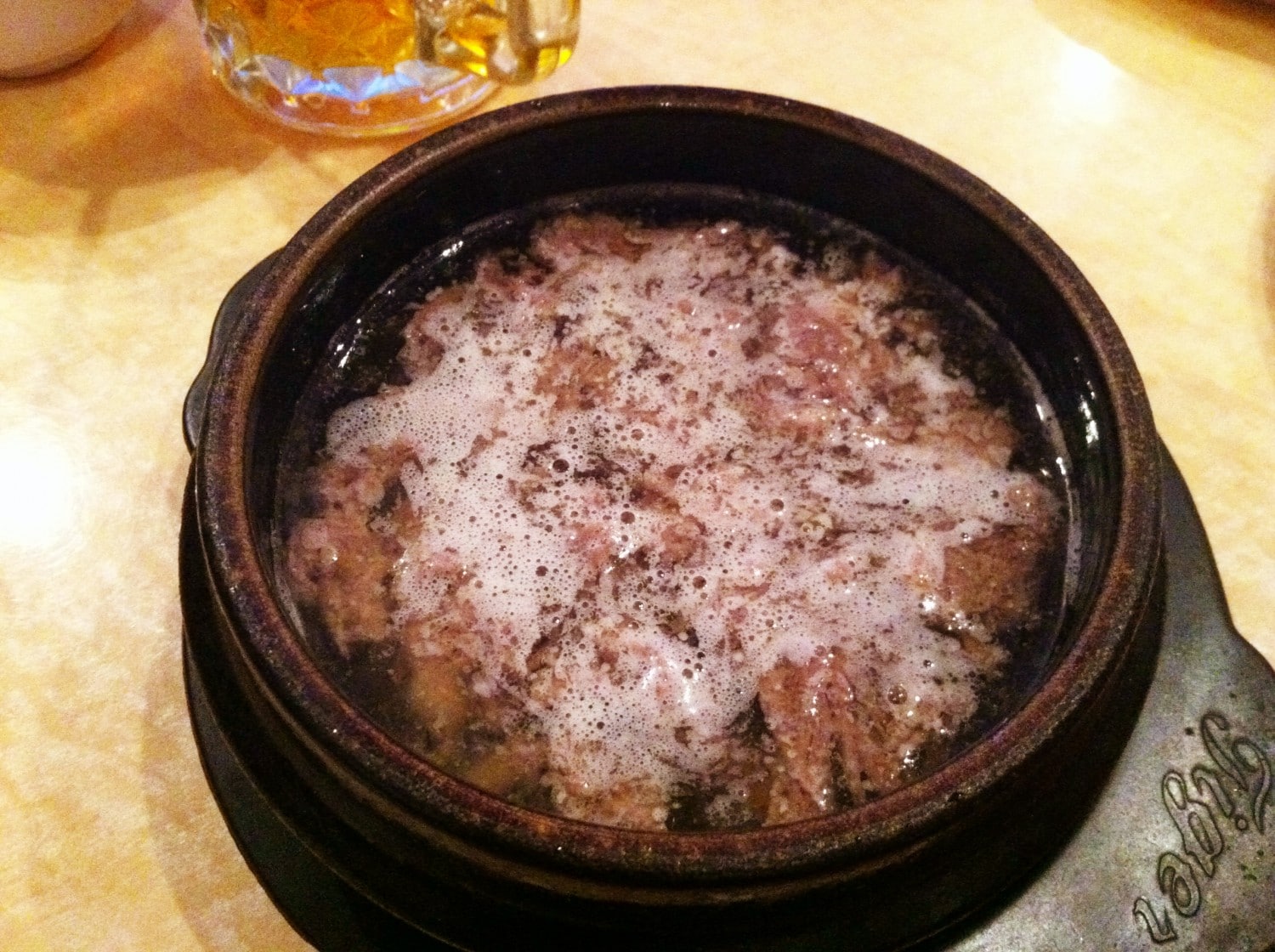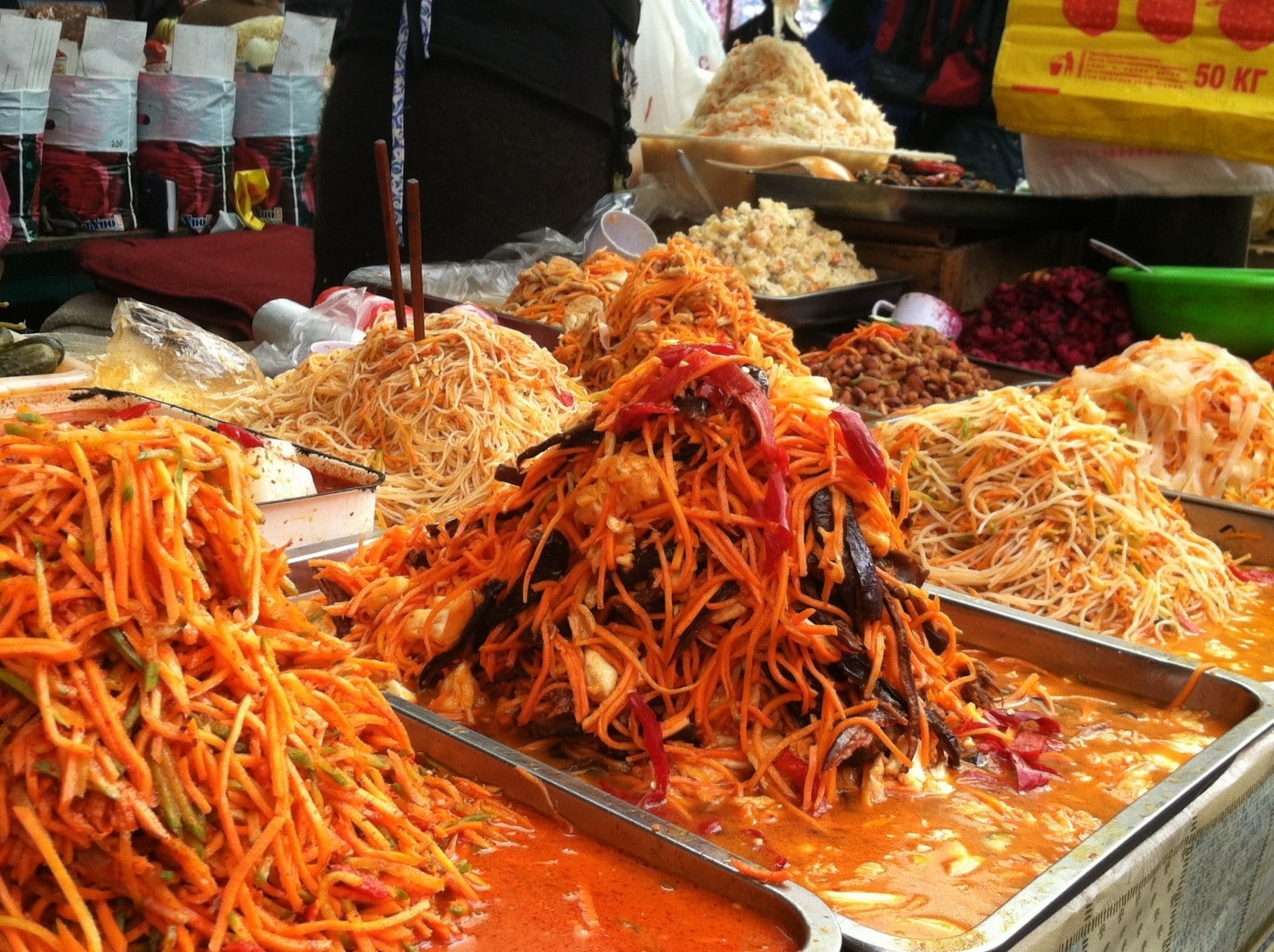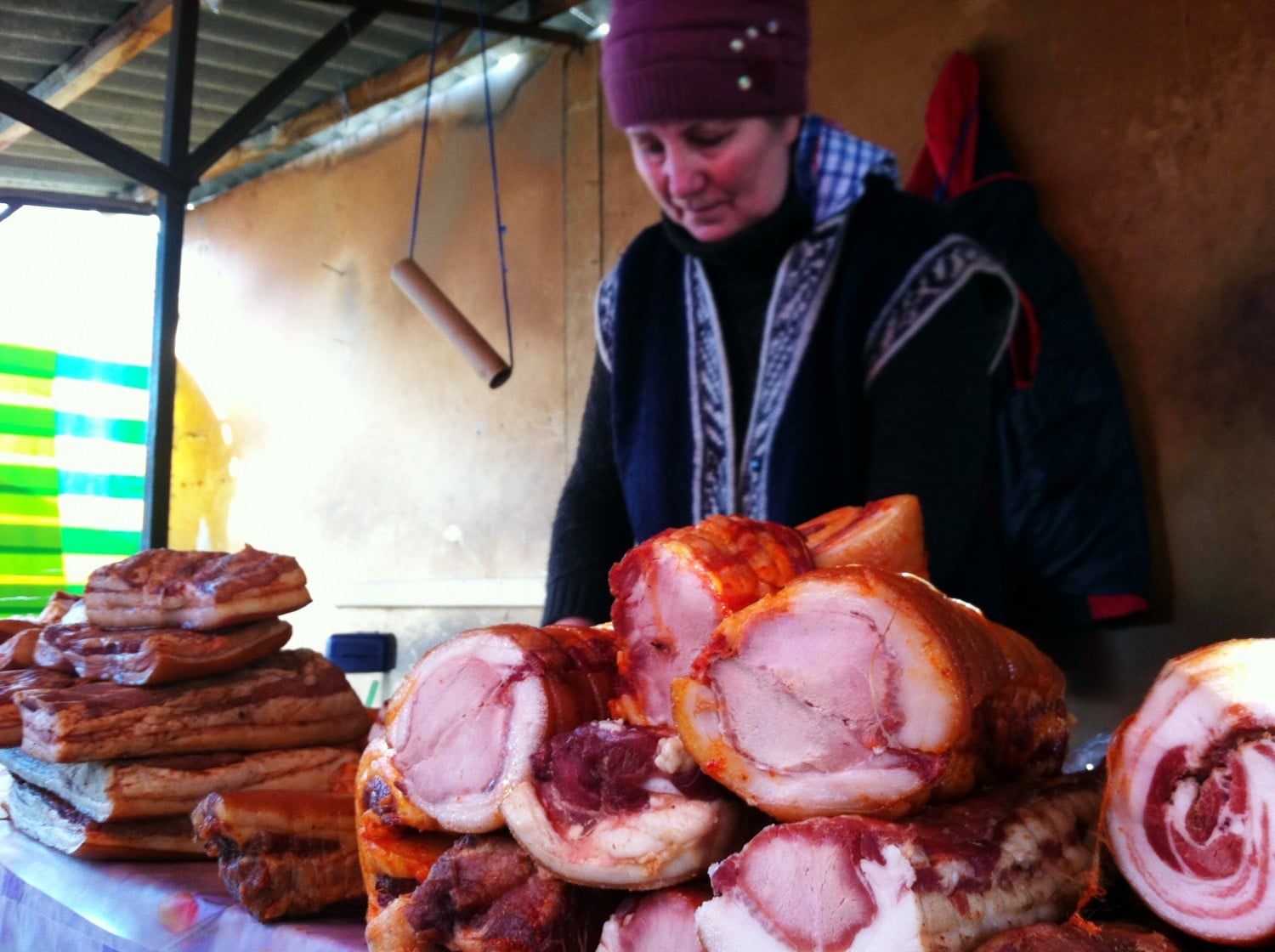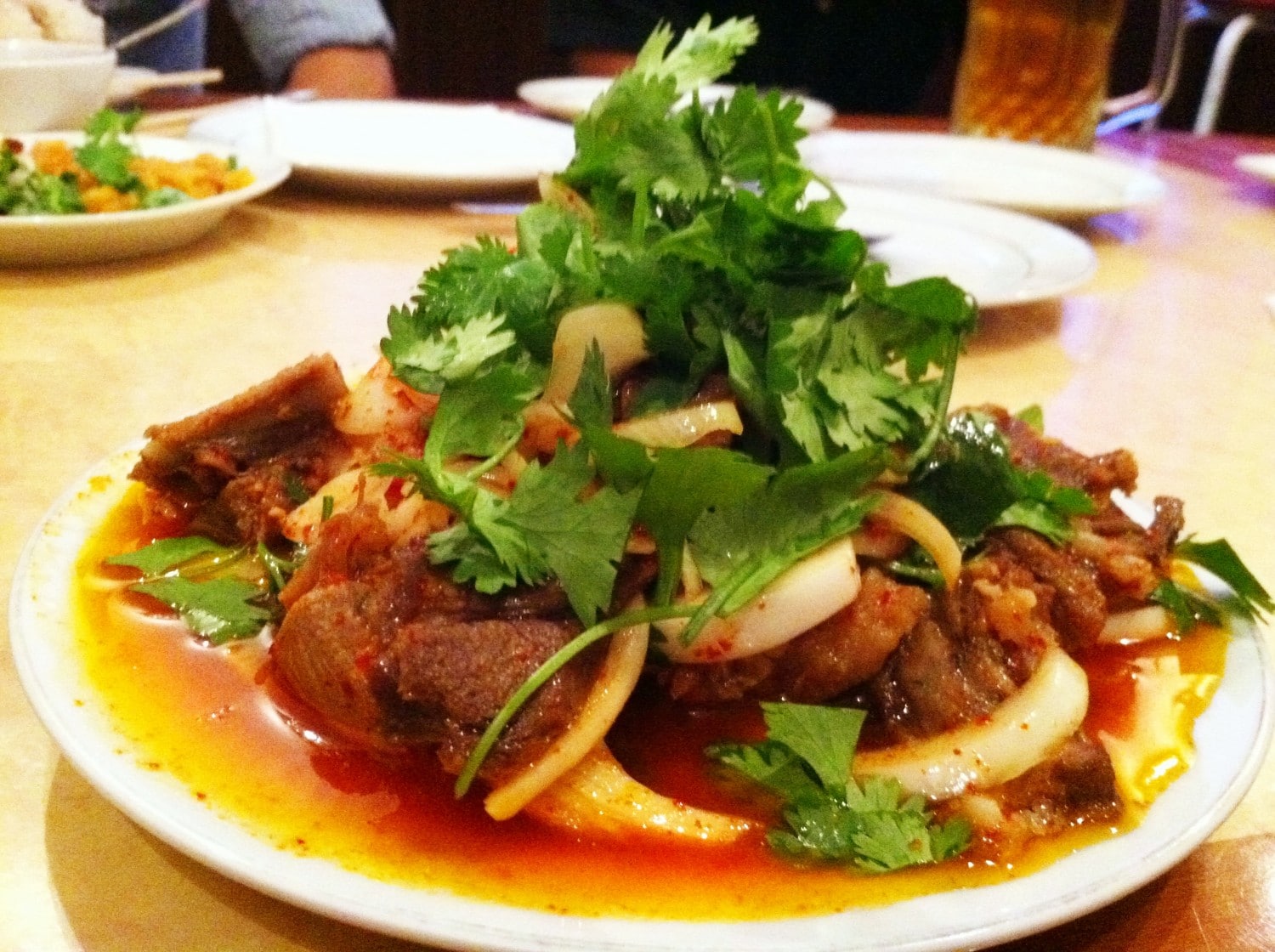It is well known that there is a significant Korean population in Kyrgyzstan today because Stalin deported Koreans living in the Russian Far East during World War II to prevent them from cohorting with the Japanese. These post-Soviet ethnic Koreans call themselves the Koryo saram. Koryo refers to Korea from the years 918 AD to 1392, and saram means “person.” What is less known is that these Koryo saram have a unique cuisine that is separate and worlds apart from their South Korean brethren who have only arrived in Kyrgyzstan in 1991 (and even more so in the last 10 years) to start up businesses.
Koryo saram cuisine is a mix of North Korean (specifically, the Hamgyong province), Central Asian, and Russian flavors. One evening, my friends and I went to a Koryo saram eatery called Restaurant 134, which is owned by descendents of Koreans deported by Stalin in the late 1930s. What we found on the menu were many items we couldn’t read or understand because of their transliterations from Korean. Fortunately, our waitress was quite patient and explained to us the meaning of certain items. For example, “heh” (in Russian, хе) means “stirfry.”

The first thing we noticed about the menu was that it lacked most of the stuff we were used to ordering in Korean restaurants back home in the States. Granted, this was our first experience at a Koryo saram restaurant, so we didn’t know what to expect. But there was no banchan, or “side dishes” of fermented vegetables. There was no bulgogi, grilled marinated beef. There was a very meager sushi menu (which, although Japanese, is a staple of most South Korean menus). For a second, I thought some of my dining companions were going to bail on our meal. What the dining menu did have was Central Asian fare such as manti and plov. It had Russian borsch and okroshka and blini. It had an extensive vodka and cigarette menu. And it had dog — specifically, dog stirfry (kya he) and dog-and-beef soup (kyadyai s myasom syp). Vot. This is actually why I came here.
Dog meat is probably the most “infamous” food item of the Koryo saram — “infamous” in the sense that it’s usually the expat answer to the question, “What’s the weirdest thing you’ve ever eaten in Bishkek?” To the Koryo saram, however, and indeed for many Southeast Asian countries, including southern China, Hong Kong, Japan, Vietnam, and the Philippines, dog meat is an ancient delicacy with a recorded history as far back as Confucius’ time in China, circa 500 BC. In 1885, a translated handbook of ancient rituals, Li Ji, included dog meat in its one of its recipes: a fried rice dish with canine, wolf breast, and dog liver basted in its own fat. Apparently, during that same period of Confucius, an emperor who wanted more warriors gave a “succulent puppy” to any woman bearing a boy. Dog meat, however, is more than a historical tradition. Dog soup, for example, is considered a hearty winter dish. It is supposed to be good for liver ailments, malaria, and jaundice (a yellowish staining of the skin.) Furthermore, dog meat is supposed to enhance virility. I also heard that dog wine, a mix of distilled grain alcohol (soju) and dog feces, soothes weariness. Last but not least, dog meat is quite tasty, like tender beef.

Of course, dog meat is not without controversy in Bishkek — or, for that matter, in the world. In Krygyzstan, where the majority of the population is Muslim, dog meat is considered haram, or ritually unclean. One of my Tajik friends said dogs are one of the dirtiest animals in the world. Their meat makes the body “too hot,” and is therefore unhealthy and harmful for the soul. I found this remark interesting because this “hot” feature is exactly what attracted the Chinese to dog meat in the first place. As Jerry Hopkins of Extreme Cuisine: The Weird and Wonderful Food that People Eat writes, dog meat “was considered to be very good for the yang, the male, hot, extroverted part of human nature, as opposed to the female, cool, introverted yin. It was believed to “warm the blood.” Meanwhile, my Uzbek friend said she never buys Korean carrot salad, or markov-tcha, from the Koryo saram babushkas at the bazaars here in Bishkek because she thinks they mix dog fat into it.
Meanwhile, for most Americans, eating dog is culturally just wrong. I think a big part of it is our pets. In America, pets are our family members. For instance, I have a fluffy Japanese Spitz named Rui, and he gets a Christmas present along with everyone else every year. As if to remind me of where I come from, as I was about to take my first bite of the dog stir fry, my friend from Seattle showed me a picture of his pet dog on his iPhone. Then when I started chewing, the other Americans in the group blinded me with the flashes of their cameras, and then looked at me as if I had just chomped on a rat (yet another culturally taboo food item in the States.) Needless to say, I felt the pangs of guilt after I left the restaurant.

It did get me thinking, though, about certain foods, and how they’re perceived by different cultures, and how one culture’s delicacy can be another culture’s metaphoric “rat.” I thought about pork, which Muslims consider haram, which is both a staple and a delicacy in, say, the Philippines and Ukraine. In the Philippines, lechon, or a roasted pig on a spit, is the mark of a huge celebration or occasion, with the most coveted part being the crisp, golden-brown skin served with liver sauce. Yet for about 60 percent of the world (the world’s approximate Muslim population), eating this animal is haram. Meanwhile, in Ukraine, salo, or pork lard, is also a delicacy, eaten raw. For many, salo is to Ukraine what fois gras (duck or goose liver) is to France. Maybe if I had a pet pig at home, like Wilbur in E.B. White’s classic novel, I’d feel differently about eating lechon and salo. Or maybe not.
I also thought about horse. In Kyrgyzstan, and many other Central Asian nations, horsemeat is a food staple, found in revered national dishes like beshbarmak, a noodle dish that is often made with horsemeat. However, in Turkmenistan, just one country away, eating horse is just wrong. When I visited Ashgabad as part of an SRAS excursion, my tour guide explained to me that he never in his life touched horsemeat, and never will. Turkmens love their horses too much, and especially their Akhal-teke horse, which are some of the fastest and most powerful horses in the world. He said horse is a Turkmen’s best friend. In Turkmenistan, horses are buried with the same respect as humans. There is even a special Horse Ministry in Turkmenistan to protect the Akhal-teke horse, which has become the de facto symbol of Turkmen national pride. I have a feeling that if one day he did decide to eat a horse, just out of pure curiosity, it would probably go down the same way mine did: with aghast, flashing cameras, and then guilt.

I also thought about goat in Kyrgyzstan, and the tradition of beheading it and draining it for the Kyrgyz national game of kukburu (which is similar to polo, but with a goat carcass instead of a ball) and then eating it. Apparently, the goat meat is especially tender after a game because it’s been hurled, tugged, and tossed around. I have to admit, while I’ve never tried goat post-kukburu, I have a hard time wrapping my head around the idea of eating an animal that has been beheaded in front of an audience, and then whipped around a dusty stadium to the sound of thunderous applause. It sounds a bit too Gladiator for me, even if the goat was already dead. But that’s just my personal taste.
I guess when it comes down to it, people eat “weird” foods all the time. And that’s what I’ve learned from Restaurant 134. I didn’t do anything “weird” or “extreme,” or anything deserving of the paparazzi. I simply ate something that cultures around the world, including the American Indians, have been eating for centuries.
I’ve also realized that it’s not only what we as Americans eat that’s “weird,” but how we eat, and in what quantities we eat. As much as we hate to admit it, of all the developed countries in the world, we have the second highest number of obese people, only after Mexico. Today in America, two in three adults, and one in three children are overweight or obese. And so many times I am asked by Kyrgyz locals why Americans eat McDonalds everyday and are fat. Now, that’s a weird reputation to have. I of course tell the Kyrgyz that not all Americans are fat, not all Americans eat fast food, and that not all Americans who eat fast food are fat, and that the reasons behind our nation’s obesity epidemic are complicated. But like a Turkmen eating beshbarmak, a conservative Muslim eating salo, and an American eating dog, the fact is, many people consider food culture in America just wrong.
All things considered, I am not ashamed that I tried “succulent dog” and thought it was good. That being said, I probably won’t order it again, just because I don’t think my American sensibilities could handle the experience twice. But I will look at food culture more open-mindedly. And I will think twice before passing judgment on anything “weird” and “extreme.”





